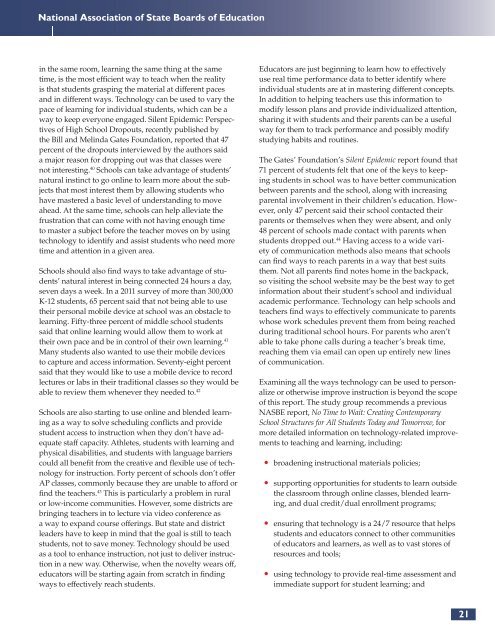Create successful ePaper yourself
Turn your PDF publications into a flip-book with our unique Google optimized e-Paper software.
National Association of State Boards of Education<br />
in the same room, learning the same thing at the same<br />
time, is the most effi cient way to teach when the reality<br />
is that students grasping the material at different paces<br />
and in different ways. Technology can be used to vary the<br />
pace of learning for individual students, which can be a<br />
way to keep everyone engaged. Silent Epidemic: Perspectives<br />
of High School Dropouts, recently published by<br />
the Bill and Melinda Gates Foundation, reported that 47<br />
percent of the dropouts interviewed by the authors said<br />
a major reason for dropping out was that classes were<br />
not interesting. 40 Schools can take advantage of students’<br />
natural instinct to go online to learn more about the subjects<br />
that most interest them by allowing students who<br />
have mastered a basic level of understanding to move<br />
ahead. At the same time, schools can help alleviate the<br />
frustration that can come with not having enough time<br />
to master a subject before the teacher moves on by using<br />
technology to identify and assist students who need more<br />
time and attention in a given area.<br />
Schools should also fi nd ways to take advantage of students’<br />
natural interest in being connected 24 hours a day,<br />
seven days a week. In a 2011 survey of more than 300,000<br />
K-12 students, 65 percent said that not being able to use<br />
their personal mobile device at school was an obstacle to<br />
learning. Fifty-three percent of middle school students<br />
said that online learning would allow them to work at<br />
their own pace and be in control of their own learning. 41<br />
Many students also wanted to use their mobile devices<br />
to capture and access information. Seventy-eight percent<br />
said that they would like to use a mobile device to record<br />
lectures or labs in their traditional classes so they would be<br />
able to review them whenever they needed to. 42<br />
Schools are also starting to use online and blended learning<br />
as a way to solve scheduling confl icts and provide<br />
student access to instruction when they don’t have adequate<br />
staff capacity. Athletes, students with learning and<br />
physical disabilities, and students with language barriers<br />
could all benefi t from the creative and fl exible use of technology<br />
for instruction. Forty percent of schools don’t offer<br />
AP classes, commonly because they are unable to afford or<br />
fi nd the teachers. 43 This is particularly a problem in rural<br />
or low-income communities. However, some districts are<br />
bringing teachers in to lecture via video conference as<br />
a way to expand course offerings. But state and district<br />
leaders have to keep in mind that the goal is still to teach<br />
students, not to save money. Technology should be used<br />
as a tool to enhance instruction, not just to deliver instruction<br />
in a new way. Otherwise, when the novelty wears off,<br />
educators will be starting again from scratch in fi nding<br />
ways to effectively reach students.<br />
Educators are just beginning to learn how to effectively<br />
use real time performance data to better identify where<br />
individual students are at in mastering different concepts.<br />
In addition to helping teachers use this information to<br />
modify lesson plans and provide individualized attention,<br />
sharing it with students and their parents can be a useful<br />
way for them to track performance and possibly modify<br />
studying habits and routines.<br />
The Gates’ Foundation’s Silent Epidemic report found that<br />
71 percent of students felt that one of the keys to keeping<br />
students in school was to have better communication<br />
between parents and the school, along with increasing<br />
parental involvement in their children’s education. However,<br />
only 47 percent said their school contacted their<br />
parents or themselves when they were absent, and only<br />
48 percent of schools made contact with parents when<br />
students dropped out. 44 Having access to a wide variety<br />
of communication methods also means that schools<br />
can fi nd ways to reach parents in a way that best suits<br />
them. Not all parents fi nd notes home in the backpack,<br />
so visiting the school website may be the best way to get<br />
information about their student’s school and individual<br />
academic performance. Technology can help schools and<br />
teachers fi nd ways to effectively communicate to parents<br />
whose work schedules prevent them from being reached<br />
during traditional school hours. For parents who aren’t<br />
able to take phone calls during a teacher’s break time,<br />
reaching them via email can open up entirely new lines<br />
of communication.<br />
Examining all the ways technology can be used to personalize<br />
or otherwise improve instruction is beyond the scope<br />
of this report. The study group recommends a previous<br />
<strong>NASBE</strong> report, No Time to Wait: Creating Contemporary<br />
School Structures for All Students Today and Tomorrow, for<br />
more detailed information on technology-related improvements<br />
to teaching and learning, including:<br />
broadening instructional materials policies;<br />
supporting opportunities for students to learn outside<br />
the classroom through online classes, blended learning,<br />
and dual credit/dual enrollment programs;<br />
ensuring that technology is a 24/7 resource that helps<br />
students and educators connect to other communities<br />
of educators and learners, as well as to vast stores of<br />
resources and tools;<br />
using technology to provide real-time assessment and<br />
immediate support for student learning; and<br />
21


